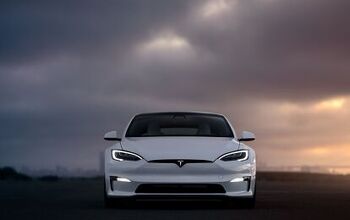6 Views
A Look At Western Europe's Most Popular Brands From 25 Years Ago
by
Derek Kreindler
(IC: employee)
Published: September 9th, 2014
Share
From The Machine That Changed The World and the Financial Times: a companion to our article showing a breakdown of the most popular brands in Europe today.
While Volkswagen is still dominante, Both of PSAs nameplates have fallen from their former glory to be also-ran brands on the continent. Fiat, while strong regionally, has weakened significantly. Rover no longer exists. Volvo is practically a non-entity.
On the other hand, the Japanese can no longer be lumped into a singular entity (Nissan is particularly strong in Europe, with the Qashqai and Juke), and the Koreans are wholly absent from this chart. Meanwhile, Hyundai and Kia are challenging some established European brands in their home markets?
Derek Kreindler
More by Derek Kreindler
Published September 9th, 2014 5:22 PM


































Comments
Join the conversation
Great story. I'd guess Fiat's downfall is the greatest difference. Also, if we lump Koreans and Japanese together today, how much more than 10% they have today? Without researching, but venturing from memory, it'd seem Fiat's downfall can be traced to the growth of German brands and the continued lack of strength in anything but the compact categories. It seems European cars have grown over the last couple of years and now cars Golf sized are the leaders while back in the 90s it'd be Polo sized. Add to that the contraction in Southern Europe, the inability of Fiat to sell in Northern Europe and you have your reasons for the contraction. Because to me, at first glance, total market participation of the others has more or less stayed the same. Let's see if the new 500X debuting in Paris and the continued presence of Jeep in Europe help FCA get back to a more comfortable double digit participation. Some say that with the new 500X and Italy improving a bit next year, Fiat could close 2015 at close to 8%.
I hav edone similar comparision between early 90s to current conditions- at ACEA website they are stats since 1990 passenger car sales - so i guess this is also passenger cars with WE market at 13.5 million it is PC only without LCV´s. must be said that Ford and Opel were back than as big as VW- here you have groups, but VW brand wasn´t bigger than Ford and Opel in early 90s, even Opel was some time No.1 brand in Europe than Ford too, than VW and in late 90s-2000 REnault was No.1 1year too. Now most important factors and differences are: 1.Koreans came - they were non-factor in 1989, including Koreans i count also Chevrolets 2. FIAT group and FIAT brand- biggest decline from all top brands-automakers, FIAT was back than dominant in Italy and it was small car manufacterer with bigger line-up than this days and far bigger market share in small cars and in Italy overall market share was bigger - Lancia is dead brand basically this days and Alfa is also few times smaller than it used to be. 3.Rise of premium brands-mostly German 3 MB,BMW, Audi-their market share is visibly higher, but also other brands like Land Rover or Porsche are far bigger this days - it has to do with premium brands introducing cheaper cars and bigger line-ups. 4.1989 there was still Eastern bloc and SKoda had limited succes in west, now as member of VW group Skoda is among top 10 brands in many western countries, the same goes with Dacia when REnault introduced them to western Europe, Skoda-Dacia together now have pretty good market share, while in 89 i don´t know if Dacia was selling and Skoda was non-factor small brand
Indeed, 1989 was the year that the Berlin wall fell. Europe was going thru a major political, (and later economical) re-alignment. It is not surprising that in this realignment the weaker companies fell by the wayside.
All the mainstream European brands have fallen since the late 80s due to the market shift to premium brand large cars and CUVs. Ford, Opel, Peugeot, Renault, and Fiat were selling a pretty large number of Sierra's, Omegas, 605, Lagunas, and Cromas respectively in those days, but today the large car buyers go to BMW, Audi, and MB. The mass-market brands are now stuck in the low profit small car segments with increasing competitors from Korea and soon China. VW is the exception, although much of its growth is due to Audi and now Porsche. Fiat has not been able to do the same with either Lancia or Alfa, GM has not been able to establish Cadillac or build Saab, and Ford was not successful in growing Jaguar or Volvo, which is why they are all bleeding red ink in Europe.